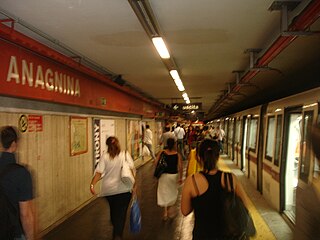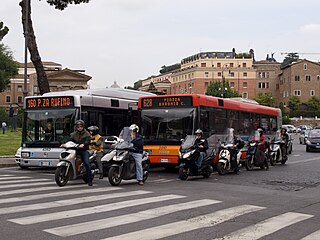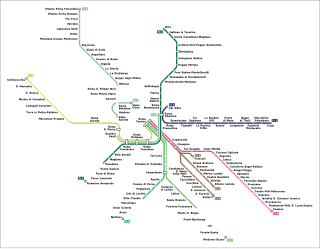
Rome–Ciampino International Airport "G. B. Pastine" is the secondary international airport of Rome, the capital of Italy, after Rome-Fiumicino Airport "Leonardo da Vinci". It is a joint civilian, commercial and military airport situated 6.5 NM south southeast of central Rome, just outside the Greater Ring Road the circular motorway around the city.

The Rome Metro is a rapid transit system that operates in Rome, Italy. It started operation in 1955, making it the oldest in the country.

Battistini is an underground station on Line A of the Rome Metro, situated at the junction of Via Mattia Battistini and Via Ennio Bonifazi, in the 14th district. The station was inaugurated, together with the others from Valle Aurelia - Battistini on 1 January 2000 since when it has been the northernmost station on Line A.

Spagna is an underground station on Line A of the Rome Metro, in the rione Campo Marzio, which was inaugurated in 1980.

Barberini–Fontana di Trevi is an underground station on Line A of the Rome Metro, inaugurated in 1980 and situated under Piazza Barberini in Trevi. Originally, the station was simply named Barberini, and the name was extended in 2000.

Anagnina is a station of Line A of the Rome Metro. It is located at the junction between Via Tuscolana and Via Anagnina, close to the depot of Osteria del Curato. The station is at an altitude of 53 metres (174 ft) above sea level.

Line B is a metro line serving Rome, Italy, and part of the Rome Metro. Despite its name, Line B was the first line to be built in the city. It crosses Rome diagonally from north-east, starting at Rebibbia and at Jonio stations, to south, terminating at Laurentina, in the EUR district. It crosses Line A at Termini station. The line has 26 stations and is shown in blue on Metro maps.

The current tram system in Rome, Italy, is a leftover from what once was the largest tram system in Italy. With its fragmented structure, it does not currently function as a backbone of the city's public transport. The system is owned and operated by Azienda Tranvie e Autobus del Comune di Roma.

Rome is a tourist destination of archaeological and artistic significance. Among the most significant resources are museums – —aqueducts, fountains, churches, palaces, historical buildings, the monuments and ruins of the Roman Forum, and the Catacombs. Rome is the 2nd most visited city in the EU, after Paris, and receives an average of 7–10 million tourists a year, which sometimes doubles on holy years. The Colosseum and the Vatican Museums are the 39th and 37th (respectively) most visited places in the world, according to a recent study. In 2005 the city registered 19.5 million of global visitors, up of 22.1% from 2001. In 2006, Rome was visited by 6.03 million international tourists, reaching 8th place in the ranking of the world's 150 most visited cities. The city has also been nominated 2007's fourth most desirable city to visit in the world, according to lifestyle magazine Travel + Leisure, after Florence, Buenos Aires and Bangkok. Rome is the city with the most monuments in the world.

The FL lines, formerly Lazio regional railways consist of 8 commuter rail lines operated by Trenitalia, converging on the city of Rome.

Rome has an extensive internal transport system and is one of the most important road, rail and air hubs in Italy.

Municipio I is an administrative subdivision of the municipality of Rome, encompassing the centre of the city.

The Roma–Giardinetti railway is a narrow gauge on-street railway which connects Laziali with Giardinetti to the east just past the Grande Raccordo Anulare, Rome's orbital motorway. It is run by ATAC, the company responsible for public transportation in the city, which also operates the Rome Metro.

The FL5 is a regional rail route. It forms part of the network of the Lazio regional railways, which is operated by Trenitalia, and converges on the city of Rome, Italy.

The FL7 is a regional rail route. It forms part of the network of the Lazio regional railways, which is operated by Trenitalia, and converges on the city of Rome, Italy.

The FL8 is a regional rail route. It forms part of the network of the Lazio regional railways, which is operated by Trenitalia, and converges on the city of Rome, Italy.

ATAC S.p.A. is an Italian publicly owned company running most of the local public transportation services, paid parking and incentive parking lots in Rome. More specifically, the company handles, on behalf of Roma Capitale Authority, the entire tramway, trolleybus network and metro lines, as well as most of the bus lines in the city. It also operates, on behalf of the Administrative Region of Lazio, three railways: Roma-Civita Castellana-Viterbo, Roma-Giardinetti and Roma-Lido. ATAC S.p.A., with its 2,200-kilometer-wide public transport network, its over 8,500 busses and 70,000 parking stalls, is currently one of the biggest public transportation companies in Europe and the largest in Italy.

The Metrebus Card is a contactless smartcard ticketing system for Rome. It has stored value on a paper ticket for either 1, 3 or 7 days. All three versions of the tickets look the same on the front, but on the back of the ticket the magnetic data printed on the ticket varies depending on which version of the ticket was purchased.

Metropolitan City of Rome Capital is an area of local government at the level of metropolitan city in the Lazio region of Italy. It comprises the territory of the city of Rome and 120 other comuni in the hinterland of the city. With more than 4.3 million inhabitants, it is the largest metropolitan city in Italy.
























